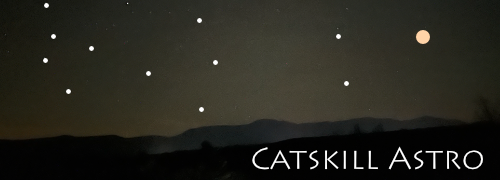Messier Objects
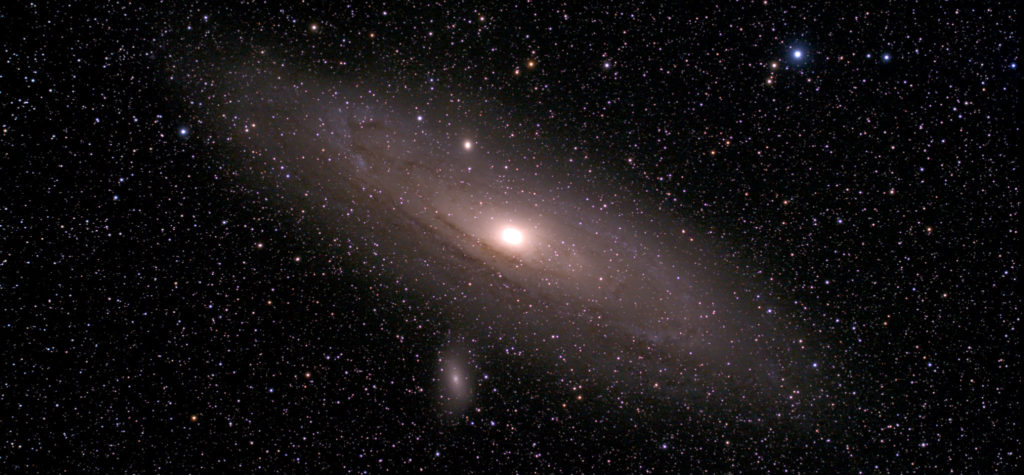
Page 9 of 11
Messier observations 81-90 of 110 total to date.
| Catalog # | Thumbnail | Title/link | Description |
|---|---|---|---|
| M81 |  |
M81 / Bodes Nebula / NGC 3031 | Recorded February 9, 1781: "A nebula near the ear of the great Bear [Ursa Major].... This nebula is a little oval, the center clear, & one can see it well in an ordinary telescope of 3.5 feet [FL]. It was discovered by M. Bode at Berlin on December 31, 1774, & by M. Méchain, in the month August 1779." <--> One of the most spectacular galaxy targets in the northern hemisphere, visible most months due to its circumpolar location at Dec +69°. This is a favorite target that I've imaged many times, and often at EAA star parties: solo, in a duet with M82, a triplet adding NGC 3077, and intriguingly adding Coddington's Nebula, a dark, dwarf galaxy. The gallery features M81 solo, captured recently with my new 2600mc camera, and includes additional images of both the triplet and quartet. M81, by itself, is a beautiful, bright, spiral galaxy viewed 3/4. |
| M82 |  |
Arp 337 / Cigar Galaxy / M82 | Recorded February 9, 1781: "Nebula without star, near the preceding [M81]; both are appearing in the same field of the telescope, this one is less distinct than the preceding; its light faint & [it is] elongated: at its extremity is a telescopic star. Seen at Berlin, by M. Bode, on December 31, 1774, & by M. Méchain in the month August 1779." Halton Arp included M82 as one of 11 Messier "Peculiar Galaxies" in the "Miscellaneous" category, and commented "Internal explosion" <--> The broad outlines of this disrupted spiral galaxy are immediately obvious, but the details of the galactic center -- Arp's 'internal explosion' -- emerge much more slowly. Our view is nearly edge-on, and the spiral disk bends slightly near the the center towards the left. The base of the disrupted/exploded core is readily visible. Its furthest boundary is less clear. At star parties, when I explain my personal fascination with "Peculiar Galaxies", I usually offer this as the live EAA example. As with all of my Arp observations, the first image in the gallery is a comparison of my capture to the image Arp provided in his Atlas. Most were imaged using the 200" Hale Telescope on Mt. Palomar, on 5"x7" photographic plates. I created an inverted monochrome version of my capture that follows the comparison shot which shows the disruption a little more clearly, though less than Arp's does. |
| M83 |  |
M83 / Southern Pinwheel Galaxy / NGC 5236 | Cataloged February 17, 1781: "Nebula without star, near the head of Centaurus: it appears as a faint & even glow, but it is difficult to see in the telescope, as the least light to illuminate the micrometer wires makes it disappear. One is only able with the greatest concentration to see it at all: it forms a triangle with two stars estimated of sixth & seventh magnitude... M. de la Caille has already determined this nebula." <--> This barred spiral galaxy appears distorted by prior encounters, with the upper arm pulled out slightly with an extended tail upwards. At Dec -30°, it is a very tough target from the Catskills (42°N) as it maxes out about 18° altitude (17° at capture time). The moon was rising, and clouds emerging. It took me half an hour to capture these 4m 30s, and I figured any more time would likely make the image worse. So I stretched the heck out of it in Affinity Photo to allow me to see some detail. I was amazed that this is a Messier object, given that Paris is even further north than the mid-Hudson valley. Then learned this object was discovered at the Cape of Good Hope in South Africa, and added based on correspondence. Impressive that Messier could observe it himself (as he clearly did) from Paris, which is even further north than I am. Anyway, a truly fascinating galaxy... |
| M84 | 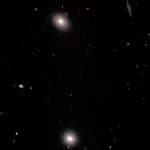 |
M84 / NGC 4374 | The first of 9 entries added to the Messier catalog on March 8, 1781, 14 within a week. Also, the first discovery (#35) credited to Messier since M70, 5 months earlier. "Nebula without star, in Virgo; the center it is a bit brilliant, surrounded with a slight nebulosity: its brightness & its appearance resemble that of those in this Catalog, No.s 59 & 60." <--> As shown in the annotated image, M84 is the lower of the two bright galaxies. Along with M86, this is a classic pair of Messier elliptical/lenticular galaxies. As most amateur astronomers, I don't find elliptical galaxies particularly compelling unless there's something going on like a jet in M87. But I do find this trio of M84 / M86 / NGC 4402 quite attractive. There's some confusion about how to classify this pair: the NASA.gov website classifies M84 as elliptical and M86 as elliptical/lenticular. Imaged on an unexpected evening that started with poor transparency and ended up pretty good. This observation was captured in the middle of that transition. |
| M85 | 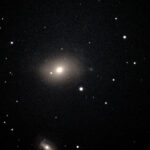 |
M85 / NGC 4382 | The second of 9 entries added to the Messier catalog on March 8, 1781, this one credited to Méchain: "Nebula without star, above & near to the ear of the Virgin [Virgo], between the two stars in Coma Berenices... this nebula is very faint. M. Méchain had determined its position on March 4, 1781.' Apparently Messier did not feel it necessary to confirm the observation. <--> A bright lenticular galaxy, it's virtually featureless except for the segmentation between the bright center and its dimmer periphery. A lenticular galaxy is a spiral in transition to elliptical (spirals have defined arms). Both are older galaxies that are no longer creating new stars. M85 is interacting with the two, larger galaxies you see in the image: NGC 4394 and IC 3292. |
| M86 |  |
M86 / NGC 4406 | The third of 9 entries added to the Messier catalog on March 8, 1781, also (#36) credited to Messier. "Nebula without star, in Virgo, on the parallel & very near to the nebula above, No. 84: their appearances are the same, & both appear together in the same field of the telescope." <--> As shown in the annotated image, M86 is the higher of the two bright galaxies. Along with M84, this is a classic pair of Messier elliptical/lenticular galaxies. As most amateur astronomers, I don't find elliptical galaxies particularly compelling unless there's something going on like a jet in M87. But I do find this trio of M84 / M86 / NGC 4402 quite attractive. There's some confusion about how to classify this pair: the NASA.gov website classifies M84 as elliptical and M86 as elliptical/lenticular. Imaged on an unexpected evening that started with poor transparency and ended up pretty good. This observation was captured in the middle of that transition. |
| M87 | 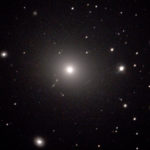 |
Arp 152 / Virgo A / M87 | The fourth of 9 entries added to the Messier catalog on March 8, 1781, also (#37) credited to Messier. "Nebula without star, in Virgo, below & very near a star of eighth magnitude.... This nebula appears at the same luminosity as the two nebulae Nos. 84 and 86." Halton Arp included M87 as Arp 152 in his Atlas of Peculiar Galaxies. He classified it with "Galaxies with Jets" and remarked "Short exposure to show jet. Virgo A radio source." <--> The toughest aspect for me was to set the black level appropriately to show the diffuse outer ring of this nebulous, elliptical galaxy while not obscuring the jet(s)... It's so large, I thought for a while my dark-subtraction in SharpCap was failing, and I was seeing amp glow! However, I was able to identify that the diffusion wasn't quite round, and not "quite" as large as uncontrolled amp-glow with my 294 sensor. This became obvious after about 15m of integration. The S/N ratio was so high, and since there is no structure to speak of in the outer disc, there seemed no advantage to continuing integration longer than the 25m once the two tiny galaxies, LEDA 139919 and UGC 7652, and the connecting jet were clear. Note that the "short exposure" Arp alludes to allows his image to show the jet right to the galactic center. My exposure wasn't so expert, and the inverted image is still blown out, but does appear to show the jet continuing a little deeper into the disk. Then a friend pointed out that it's actually second "jet" in this image that Arp did not detect: which appears as a tiny bump on the edge of the galactic core. You can see it the enlarged closeup is in the gallery. It is barely visible in the Arp photograph; note the Arp comparison is rotated 180° relative to the original capture, featured image, and jet enlargement. |
| M88 |  |
M88 / NGC 4501 | The fifth of 9 entries added to the Messier catalog on March 8, 1781, also (#38) credited to Messier. "Nebula without star, in Virgo, between two small stars & one star of the sixth magnitude, which appear at the same time as the nebula in the field of the telescope. Its luminosity is one of the faintest, & [it] resembles the one reported in Virgo, No. 58." <--> Captured in the wee hours on an evening that started with remarkable seeing, but was now rapidly degrading due to a 90%, rising moon. Considering the conditions and limited time, I think a decent observation. An elegant, spiral galaxy, and yes, if all you saw was a blur, not dissimilar from M58. |
| M89 | 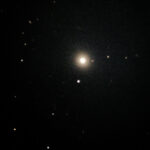 |
M89 / NGC 4552 | The sixth of 9 entries added to the Messier catalog on March 8, 1781, also (#39) credited to Messier. "Nebula without star, in Virgo, a little of distance from & on the same parallel as the nebula reported above, No. 87. Its light was extremely faint & pale, & and it is not without difficulty that one can distinguish it." <--> One more of the galaxies in the Virgo Cluster, this one a reasonably bright elliptical. Captured on a clear, but moonlit night. |
| M90 |  |
Arp 76 / M90 | The seventh of 9 entries added to the Messier catalog on March 8, 1781, also (#40) credited to Messier. "Nebula without star, in Virgo: its light is as faint as the preceding, No. 89." Halton Arp selected M90 for his Atlas of Peculiar Galaxies, categorizing "high surface companions on arms" as the peculiarity <--> Final observation of a very successful evening, completed around 1 AM. As expected for a Messier object, compared to most Arp galaxies, it is very bright. As Arp comments, IC 3583 is indeed a high surface brightness companion, though relatively distant from M90 compared to some other Arp "companions". Interactions are evident in the expansion and curvature towards IC 3583 of the NW arm, as well as a subtle dust lane that appears to connect them. This is much more evident in the inverted image compared to the color one. |
